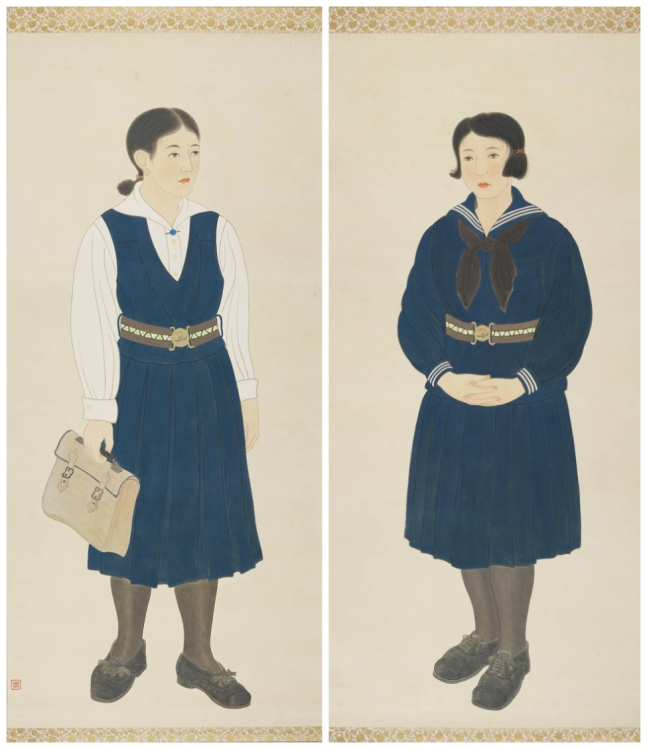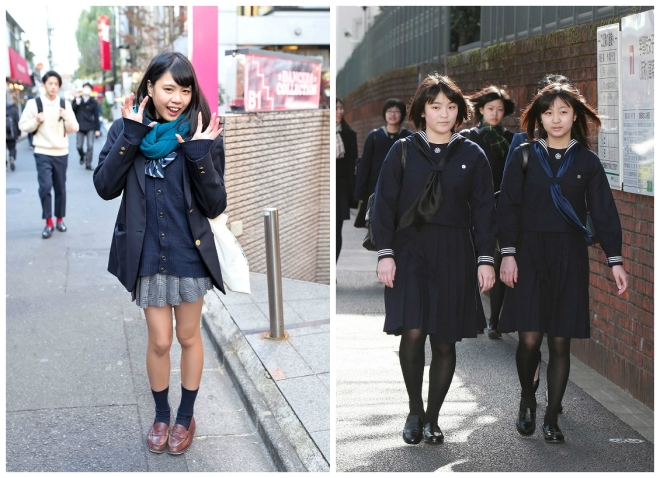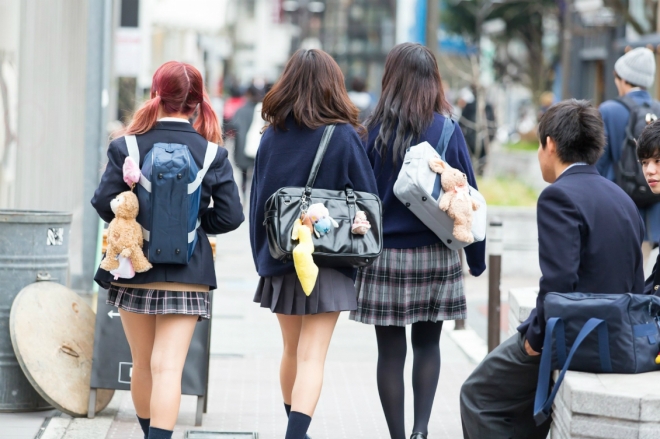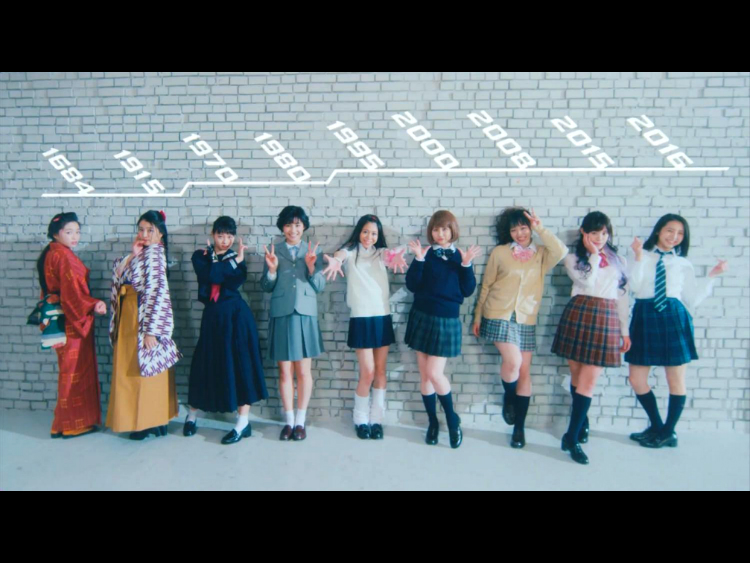Seifuku (制服, ‘systematised clothing’) is Japanese for ‘school uniform’, although often referring specifically to the type of uniform modelled on the sailor suit and worn by girls. The combination of a pleated skirt and a blouse with a wide sailor-suit collar was first introduced in 1920 at an Anglican school in Kyoto, Fukuoka Jo Gakuin, and gradually became accepted throughout the country. A hundred years later seifuku is a symbol of Japan, popularised internationally through series of anime and manga, ever-present as the outfit of magical girls (see more on Sailor Moon below), a shorthand for youth, and a popular fetish item. It was not intended as such.
Early History
School uniform as a concept first appeared during the Meiji-era in 1879, when the Gakushūin — an institution established to educate the children of Japanese aristocracy — introduced the custom. Early uniform for girls consisted of a simple kimono worn with either a wraparound skirt or hakama, loose trousers tied at the waist. Other schools followed the example of the Gakushūin, the most prestigious school in the land, and photographs of the period show classrooms of girls with identical hairstyles, wearing layered kimonos of the same fashion.
Seifuku is a symbol of Japan, popularised internationally through series of anime and manga, ever-present as the outfit of magical girls (see more on Sailor Moon below), a shorthand for youth, and a popular fetish item. It was not intended as such.
Girls continued to dress into kimonos for school much longer than boys did, with the latter changing into the gakuran (学ラン, ‘Western student’) around 1910. Gakuran is a variation of the formal military dress worn in the Japan of the 1910s, and an indirect adaptation of the Prussian army uniform. A mixed group of students from the early 20th century would include boys in black buttoned-up jackets with standing collars, with barely visible white shirts worn underneath, and in straight black trousers. Girls, on the other hand, would still be wearing kimonos, obis, and the traditional wooden sandals geta.

The Sailor Suit
Allegedly, it was the principal of Fukuoka Jo Gakuin Elizabeth Lee who replaced the traditional schoolgirls’ clothes with the sailor suit. Lee had visited Britain as an exchange student, and her invention is supposed to be based on the uniform used by the British Royal Navy at the time. I would argue that children’s sailor suits would have been more of a contributing factor:
Sailor suits had served as normal dress for British children since 1846, when Albert Edward, Prince of Wales had been gifted a miniature copy of the uniform worn by ratings on the Royal Yacht. The images of the young prince in his white suit delighted the public, and simplified versions of the outfit soon became wardrobe staples for many boys and girls (and some animated characters).
The difference in the background of Japanese school uniforms for boys and for girls, although not self-evident, is curious. If the former were intended to look like soldiers, the latter were given a fantasy outfit that did not resemble Japanese military dress — or any other type of dress worn by adults, for that matter.
When Elizabeth Lee dressed the schoolgirls of Fukuoka Jo Gakuin in sailor suits, the new uniform did not echo the regulations of the Japanese army the way gakuran did, but it had the same flavour of Westernised order that the country had been after since the Meiji period.
The difference in the background of Japanese school uniforms for boys and for girls, although not self-evident, is curious. If the former were intended to look like soldiers, the latter were given a fantasy outfit that did not resemble Japanese military dress — or any other type of dress worn by adults, for that matter. In the words of an official from Tombow Co., a prominent manufacturer of uniforms, ‘In Japan, [the sailor suits] were probably seen as adorable Western-style children’s outfits, rather than navy gear.’

The Blouse and the Blazer
Seifuku has remained remarkably unchanged since its debut in the 1920s: a navy or black pleated skirt, a top with a wide sailor-style collar, a dark scarf tied underneath. As time went on, the skirts got shorter, stopping at knee-length at the more conservative schools, such as the Gakushūin. A leaflet with the examples of their uniform for winter (long-sleeved dark blouse, black tights) and summer (short-sleeved white blouse, short white socks) shows the type of outfits worn by Japanese Princess Aiko and, previously, her cousins Princesses Mako and Kiko. Adorning the descendants to the Chrysanthemum Throne, seifuku has turned into a respectable and traditional symbol, not unlike an origami crane covered in cherry blossom in the sight of Mount Fuji.
In the 1980s some Japanese schools adopted a new type of seifuku, based on the uniform used at Catholic schools. For girls, the new outfits consisted of a blazer, a skirt, a white blouse, and a bow. The top and the bottom could be made from the same fabric, or the skirt could have a tartan pattern matching the colour of the blazer. (Think Gossip Girl, series one and two.)
Seifuku has turned into a respectable and traditional symbol, not unlike an origami crane covered in cherry blossom in the sight of Mount Fuji.
The updated version of seifuku co-exists with sailor fuku, although sailor suits are now more common at junior high schools, with older students wearing blazers instead. The combination of blazers and skirts (or blazers and trousers, for boys) allows for a greater variety of style and fabric, and that permits schools to create distinct representations of themselves. Since the uniforms are seen as material objects that express ‘school spirit’ and ‘provide order, discipline and solidarity within a school’, it is hardly surprising that majority of Japanese high schools would forego sailor fuku in favour of a school-specific uniform. A student represents their school even outside the school; a recognisable colour combination and an emblem over the breast pocket help to make the connection visible. That way when a flock of schoolgirls continuously interrupts your phone call with shouts of ‘Maji de?!’, you know exactly which principal to complain to.

Seifuku as worn in Harajuku and Shinjuku. The image on the left is a photograph of Kattrina Demesa in her school uniform, published on February 2nd, 2015 on TokyoFashion.com. The image on the right is a photograph of Princesses Mako and Kiko Akishino, taken on March 22nd, 2010 at their high school, the Gakushūin, published by the Mainichi Shimbun.
Seifuku in Anime
Outside of Japan seifuku is best known through manga and anime, two types of media heavily aimed at teenagers and often depicting high-schoolers as their protagonists. Series like Sailor Moon (1991–2016), Neon Genesis Evangelion (1995–2013), Gals! (1998–2002), Fruits Basket (1998–), Death Note (2003–2016), Durarara!! (2004–), Toradora! (2006–), Madoka Magica (2011) etc. provide countless and varied examples of seifuku. There are girls in tartan skirts with matching ties, in sailor suits worn with black stockings and white socks, in dresses and in blazers, with every possible colour combination represented. There are also some more far-fetched options, like V-shaped collars, or sentient midriff-baring blouses.
Seifuku in anime functions similarly to school uniform in real-life Japan: both are used to create a group image and to distinguish one collective from another.
Generally speaking, female characters in Japanese animation tend to have idealised and identical features, with hair colour and the cut of their dresses serving as identity markers. In Sailor Moon, a series where the characters are named after their sailor fuku, one of the Sailor Soldiers (Minako Aino, Sailor Venus) is able to successfully present herself as another (Usagi Tsukino, Sailor Moon and Princess Serenity) — which becomes an obvious plot point if you have a look at the two blondes in the image below.
Seifuku in anime functions similarly to school uniform in real-life Japan: both are used to create a group image and to distinguish one collective from another. The Sailor Soldiers are a perfect example of that approach. Another trait that Japanese schoolgirls share with their on-screen representations is the affinity for short and very short skirts. I am talking very short skirts, I am talking Paris Hilton ca. 2004.

Mini, Micro, Maxi
Miniskirts entered contemporary fashion in the 1960s, and schools throughout the world have been fighting for the hem to stay at knee level ever since. None have failed as spectacularly as Japanese high schools.
Mirroring Western trends, Japanese uniforms grew shorter in the 1960s and reached the microskirt length in the 1990s, at the height of kogal (anglicised contraction of kōkōsei gyaru, ‘high school gal’) subculture influence. Just peeking from under long and bulky school jumpers, uniform skirts are shortened either permanently or temporarily — by cutting, folding the fabric over the waistband, and using ‘skirt belt’ (raising the waist and securing it in place with a belt, as shown in this helpful diagram). Part fashion statement, part gesture of defiance, part sign of belonging to a particular group, shortened seifuku is a risky — risqué — costume to wear. Schools have skirt length checks at regular ‘appearance examinations’ and official events, and should your thighs be on display, you can be sent home or otherwise disciplined. Cue nervous laughter.
Instead of making the skirts shorter, the sukeban wore their suits down to their ankles, in a move that both fought mainstream fashion and allowed to conceal razors and chains behind the layers of fabric.
It is not uncommon for schoolgirls to keep a second, more modest skirt for the appearance checks. And while that might sound like effort, it does not compare to another practice: spray-dyeing your hair back to black in the morning before school, since hair colouring is forbidden, too, and yet, remains so fashionable. Cue thinking back to your priorities as a teenager. (Mine included sleep.)
When Twiggy visited Japan in 1967, she started off the miniskirt craze that continues to this day. Still, there have been interruptions: the 1970s saw the emergence of the sukeban (‘girl boss’), all-girl street gangs who altered the traditional sailor fuku to create a uniform of their own. Instead of making the skirts shorter, the sukeban wore their suits down to their ankles, in a move that both fought mainstream fashion and allowed to conceal razors and chains behind the layers of fabric.

At one point the sukeban had over 20,000 members, united in an organisation that provided a social structure entirely alternative to the patriarchal Japanese society. Not unlike the yakuza, the sukeban had strict subordination and predilection for violence: ‘cigarette burns were considered a minor sentence for stealing a boyfriend or disrespecting another member’. The maxi skirts worn by the girl gangs of the 1970s made them instantly recognisable; the outfits and the image of ‘bad girls’ were later used by multiple media companies to create entertainment in the range from cheesy television shows with crime-fighting heroines to — but of course — pornography.
In 2017 seifuku continues to be a practical solution, a choice, and a symbol at once.
The sukeban version of seifuku included sailor blouses cut at midriff, unusually long skirts, Converse instead of penny loafers, loose socks, and untied scarves. Deliberately scruffy, their uniform was intended as a challenge to the traditional expectations of modesty, tidiness, courtesy, and compliance. It was partly in response to the sukeban that in the 1980s many Japanese high schools changed their uniforms from the now-tainted sailor fuku to the Catholic school suits described earlier in this article. It seems that for Japan modernisation necessarily requires a tradition, if a borrowed one.
In 2017 the fashionable skirt length is down to your knee, to be combined with short socks. The complete set of seifuku for winter, summer, and exercise costs about ¥100,000 (£700). Internationally acclaimed animated drama Your Name (Kimi no Na wa, 2016) has burned through cinema theatres like a supernova, introducing new lovable characters in school uniform. Popular group AKB48 consists of over 130 girls, all of them clad in pleated tartan and singing J-pop. Seifuku continues to be a practical solution, a choice, and a symbol at once.

Current album: Haim, Something to Tell You
Current book: Lydia Davis, Can’t and Won’t
Current TV series: Sailor Moon (original title Bishōjo Senshi Sērā Mūn), Series 1 (1992–1993)
